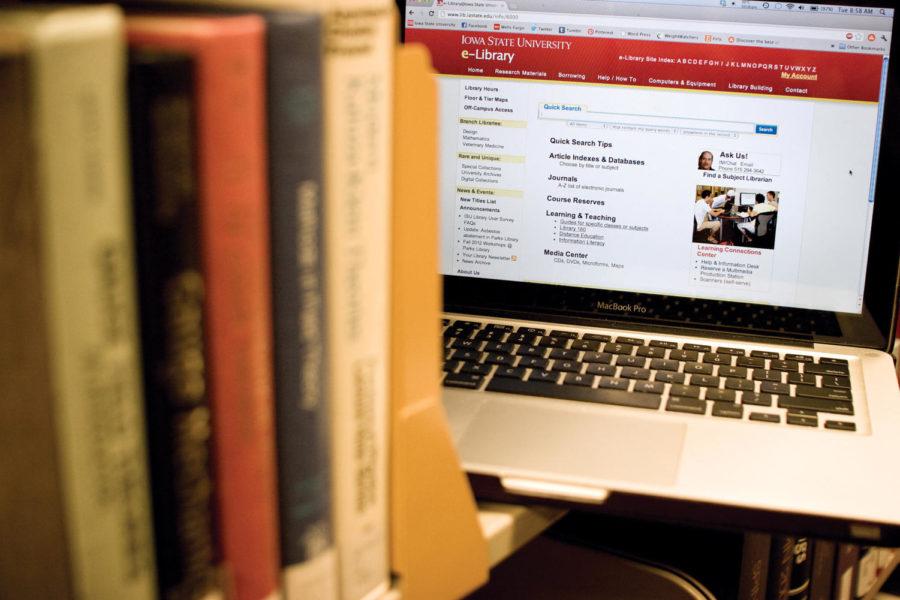E-library makes resources widely available and easy to use
September 26, 2012
Parks Library has become more efficient for students to use, with most of its resources available from the comfort of home.
In the past five years, use of Parks Library has increased nearly 50 percent. David Gregory, associate dean at Parks Library, provided some statistics. In the last five years, the collective number of entrances into the library has gone up from roughly 1.2 million to 1.8 million; use of the physical collection is up 4 percent.
The library is still buying nearly 20,000 volumes per year, but what has increased exponentially is the use of electronic resources. The library has more than 105,000 electronic journal titles, compared to 20,000 print journal titles.
“We started to purchase [e-journals and e-books] aggressively because we know that’s what people use,” Gregory said. “Students, especially undergrad, really want electronic.”
Christine King, associate dean at Parks Library, agreed with Gregory: Even media that are rarely physically checked out might still be used electronically, because it is much easier to access. She said the number of people coming to the help desk has gone down 46 percent in five years, but email questions have gone up 74 percent. The library’s chat help service usage has gone up 325 percent.
King said they are trying to make things easier at the library, and while some people may have the impression that library materials are not used anymore, it’s because there is so much available online. Students can sit in their dorm rooms or apartments and still have access to books and journal articles. They never have to physically step inside the library.
Gregory said that even the special collections, a section devoted to rare and unique material, used to be material that could be only used if a student were physically present. Although this is mostly still true, the library is starting to digitize more and make even those resources available on the e-library.
Although many resources are now available online, King said she stills thinks it’s important to come to the library.
“With this electronic revolution, there is more material published than ever,” King said.
Gregory agreed, saying the amount of material can be overpowering.
“Students are occasionally overwhelmed with just the quantity of what they find,” Gregory said. “They would really like to know what the best sources of info are. Evaluating information is becoming more and more challenging.”
This online redirection can lead to confusion and inefficiency, when students go to Google instead of the e-library’s resources.
King said she believes people are so used to using Google they think they can get by with it, but in college, this may not always be the case.
Gregory said Google is a fine place to get ideas, but it’s “casting a really wide net” in a sea of information.
“Something like the e-library website helps people be much more focused,” Gregory said. “Imagine searching a database like Google, but it’s all about your subject area: You can be much more efficient. … You don’t get all the stray information you can find in Google.”
He suggests students take advantage one of the most underutilized resources: the online indexes and abstracts. Located on the homepage under article indexes and databases, students can use the indexes to find a more specialized listing of literature.
“If you use one of those, you’re really narrowing your search to highly-relevant material in your field,” Gregory said. “They have a lot of built in features so you can refine your search … like search engines but designed to help the researcher zero in on really relevant material that generic searches aren’t [able to].”
Resources through the e-library website are selected by librarians at Iowa State. By using the site, students can be sure they are finding quality material selected by those who understand the curriculum and needs of the university community.
“I think, if anything, librarians have as big a role as ever — perhaps bigger,” King said, adding that although students do not have to go to the library working with the librarian, because the librarians can help people through email or chat, it really helps if they are. A librarian can help students navigate through materials and show them what to look for.
“It’s more of a full service approach,” King said. “You’ve got the electronic resources and services provided by librarians to back them up.”
Gregory encouraged people to come to the library because they can get much more done, much more efficiently. Students are no longer coming to the library to find a book and check it out because they are able to do much more.
“The library has almost become more of a learning laboratory,” Gregory said.

















